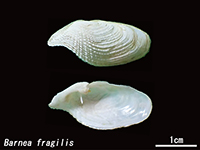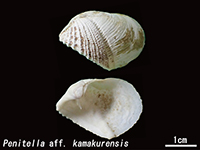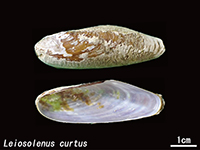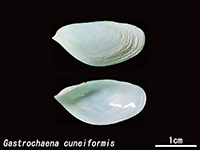日本語 / English
OWADA Masato's Home Page
— about my bird watching and molluscan research —
Boring bivalves
The boring bivalves
They are a group of mollusks characterized by a specialized lifestyle in which they bore into hard substrates such as rock and wood, inhabiting the cavities they create. This lifestyle is more commonly observed in bivalves than in gastropods. Notable examples include Cyrtopleura costata and Pholas orientalis, commonly known in Japanese as "テンシノツバサ" and "ペガサスノツバサ," respectively.
The cavities created by boring bivalves are called "burrows," characterized by a narrow entrance that widens into a larger chamber. These bivalves remain within their burrows for their entire lives. Boring is known to be accomplished through a combination of mechanical and chemical means. For example, species that primarily bore by mechanical means include members of the genera Penitella and Barnea, while those that rely mainly on chemical processes include members of the genera Leiosolenus and Gastrochaena.
Bivalves primarily boring by mechanical means
The photographs below show Barnea fragilis and Penitella aff. kamakurensis. Barnea fragilis mainly bores into mudstone, while P. aff. kamakurensis primarily bores into sandstone. Both species possess file-like sculptures on the anterior surface of their shells, which they use to bore into substrates. Interestingly, the arrangement of the hinge and adductor muscles in these bivalves differs significantly from that of common bivalves. When the posterior adductor muscle contracts, the anterior part of the shell opens. In this position, the sculptured shell surface can be pressed against the burrow wall. The shell can then rotate within the burrow along its anterior-posterior axis. As a result of this boring behavior, concentric patterns are often observed at the bottom of burrows made by B. fragilis and P. aff. kamakurensis.


Bivalves primarily boring by chemical means
The photographs below show Leiosolenus curtus and Gastrochaena cuneiformis. Leiosolenus curtus mainly bores into mudstone, while G. cuneiformis primarily bores into limestone. Both species possess entirely smooth shell surfaces and lack the file-like sculptures observed in the species that primarily bore by mechanical means. These bivalves are thought to excavate their burrows by secreting chemical substances that dissolve calcium carbonate in the substrate. The undissolved residue is then expelled from the burrow. While the secreted substances are presumed to be acids, acidic mucus, or mucus with calcium-chelating properties, their exact chemical nature remains unidentified.
Species that primarily bore by mechanical means may also secrete some of these chemical substances to facilitate burrowing. Similarly, species that primarily bore by chemical means may also use their shells to scrape away residual material from the burrow wall. For these reasons, boring bivalves are considered to use a combination of both mechanical and chemical means in their boring activities.


Burrows of the boring bivalves
Boring bivalves generally do not bore into boulders. If a boulder shifts due to waves or wind, the entrance to the burrow can become blocked, which can lead to the death of the bivalve within. Thus, they tend to bore into stable megaclasts or bedrock that are unlikely to be displaced by minor wave or wind action. As a result, their burrows are likely to be preserved as fossils.
Fossils of burrows reflect the environment in which the boring bivalves lived. Most species of boring bivalves inhabit the intertidal zone down to a depth of about 20 meters. Therefore, the location of fossil burrows can often indicate the water depth that existed at the time. In addition, the types of bored substrate and the shapes of the burrows tend to vary depending on the taxonomic group of the boring bivalves. By adding this information, it is sometimes possible to make more detailed inferences about the paleoenvironment.